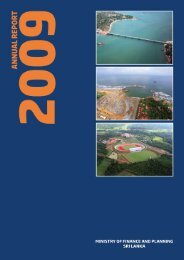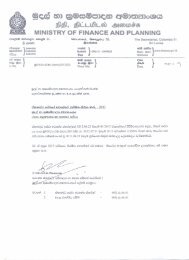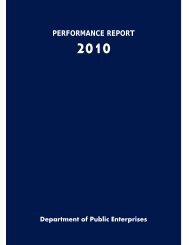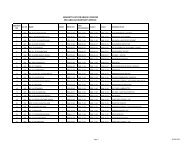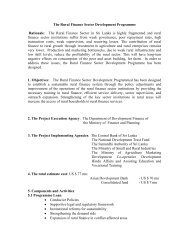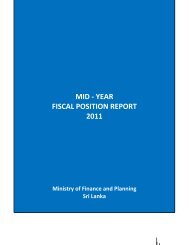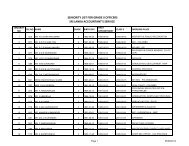The Department <strong>of</strong> National <strong>Planning</strong> hasactively participated by providinginformation <strong>and</strong> policy direction toprepare a draft <strong>of</strong> the National WaterResource Policy.The <strong>of</strong>ficers in the Department <strong>of</strong>National <strong>Planning</strong> attended the Steeringcommittee meeting <strong>of</strong> theMoragahak<strong>and</strong>a & Kaluganga ReservoirsDevelopment Project <strong>and</strong> Dam Safety <strong>and</strong>Water Resources Management Project<strong>and</strong> the project committee meeting <strong>of</strong> theUma Oya Multipurpose DevelopmentProject. In addition, <strong>of</strong>ficers haveparticipated in progress review meetings<strong>and</strong> Policy review meetings.Plantation SectorThe plantation sector plays a vital role in thecountry’s economy by contributing 3.4percent to the GDP while providinglivelihood <strong>and</strong> foreign exchange earnings. Itprovides employment to about 1.5 millionpersons <strong>and</strong> contributes 23 percent toagricultural production, while about 20percent <strong>of</strong> export earnings are generated bythe plantation sector. The sector consists <strong>of</strong>three major crops cultivations: tea, rubber<strong>and</strong> coconut, which are grown in 12 percent<strong>of</strong> the country's l<strong>and</strong> area as well as spices<strong>and</strong> other supplementary plantation cropssuch as sugar, cashew, <strong>and</strong> palmyrah.Since the strategy remains producingexcellent tea at competitive prices, in <strong>2010</strong>highest prices compared to all otherinternational tea auctions was recorded by theColombo Tea Auction due to increaseddem<strong>and</strong> for Sri Lankan origin orthodox teas.The government supported the sector throughcontinuing fertilizer support schemes for tea<strong>and</strong> rubber during the year <strong>2010</strong>. With a viewto encourage tea <strong>and</strong> rubber cultivation, thesubsidies for re-planting <strong>and</strong> new-planting fortea <strong>and</strong> rubber were also increased <strong>and</strong> it wasextended to coconut re-planting <strong>and</strong> newplantingas well. In order to uplift coconutproduction, the government has initiated theprovision <strong>of</strong> direct fertilizer (Urea <strong>and</strong>Murate <strong>of</strong> Potash) bag <strong>of</strong> 50kgs at a subsidyprice <strong>of</strong> Rs. 1,000 for coconut l<strong>and</strong>s includingall home gardens based on the number <strong>of</strong>coconut trees available in an extent <strong>of</strong> oneacre. Export Cess on raw rubber wasincreased in order to promote the value addedexports <strong>of</strong> rubber. Specially, during the year<strong>2010</strong>, due to favorable weather conditions<strong>and</strong> the continuation <strong>of</strong> the fertilizer subsidysupport, the tea sub sector recorded thehighest ever annual production <strong>of</strong> 329 millionKg. This is a growth <strong>of</strong> 13 percent comparedwith 2009. Rubber production also continuedto increase, although the coconut productionrecorded a considerable decline during theyear <strong>2010</strong>.The production <strong>of</strong> almost all other exportagricultural crops has shown a positivegrowth in <strong>2010</strong> compared with 2009. It is dueto the favorable weather conditionsprevailing <strong>and</strong> improved world dem<strong>and</strong> forspices together with the consistent increase <strong>of</strong>the prices. Accordingly, a phenomenalincrease in export volume by 49 percent to43,313 metric tons was reported in <strong>2010</strong>against 29,044 metric tons exported in 2009.The production <strong>of</strong> pepper has increased by9.8 percent to 17,323 metric tons in <strong>2010</strong>against 15,767 metric tons produced in 2009.Meanwhile, production <strong>of</strong> cloves has tripledin <strong>2010</strong> showing a huge increase to 9,559metric tons from 3,032 metric tons in 2009.The remarkable growth <strong>of</strong> cloves productioncannot be explained in terms <strong>of</strong> the boomharvest that comes every four years as aboom harvest was reported in 2008.Therefore, this increase is explained byfavorable weather conditions <strong>and</strong> higherprices. The productions <strong>of</strong> cinnamon, cocoa<strong>and</strong> Nutmeg (including mace) have increasedby 4.1 percent, 11.35 percent <strong>and</strong> 36.55154
percent, respectively to16,407 metric tons,520 metric tons <strong>and</strong> 2,376 metric tons in<strong>2010</strong>. In view <strong>of</strong> the above analysis, theproduction <strong>of</strong> all export agricultural crops hasincreased due to the additional support givenby the government to the export agriculturalsector <strong>and</strong> favourable weather conditionsprevailing throughout the year <strong>2010</strong>.The following are the specific tasksundertaken by the Department in relation tothe Plantation sector;Appraised 06 project proposals <strong>and</strong>submitted observations on 07 CabinetMemor<strong>and</strong>a in the plantation sector.The Weligama wilt disease which wasspread at an alarming rate in the SouthernProvince had made an adverse impact oncoconut farming at the end <strong>of</strong> 2009. Thus,contribution was made to reduce thespread <strong>of</strong> coconut wilt disease in the areaby initiating a project aimed atprevention, controlling, <strong>and</strong> themanagement <strong>of</strong> the disease over a period<strong>of</strong> three years from <strong>2010</strong>. Due to several reasons adverselyaffecting coconut cultivation during thepast years, coconut production has showna declining trend from 2008. In order toincrease coconut production, the NPDwas involved in the initial discussions<strong>and</strong> preparation <strong>of</strong> a Strategic ActionPlan, which is currently in progress, toincrease coconut production from 2,700million nuts to 3.650 million nuts perannum by 2015.Contribution was made to amend the acts<strong>of</strong> the institutions under the <strong>Ministry</strong> <strong>of</strong>Plantation Industries.The necessary inputs including sectoralprogress were provided to complete thesection related to plantation sector <strong>of</strong> theAnnual <strong>Report</strong> 2009 <strong>of</strong> the <strong>Ministry</strong> <strong>of</strong><strong>Finance</strong> <strong>and</strong> <strong>Planning</strong> <strong>and</strong> the MahindaChintana Development PolicyFramework.155Power, Energy & TelecommunicationsSectorAvailability <strong>of</strong> safe, quality, reliable <strong>and</strong>uninterrupted power supply is one <strong>of</strong> theimportant factors for rapid economicdevelopment <strong>of</strong> the country. Therefore, thegovernment has paid special attention to thissector <strong>and</strong> has made a significant investmentin it during the last five years.As a result <strong>of</strong> government attention, theelectrification level in the country hasincreased to 88 percent <strong>and</strong> there are 3districts namely Colombo, Hambantota <strong>and</strong>Gampaha that have 100 percent coverage. Inaddition, out <strong>of</strong> 25 districts in the country, theelectrification level <strong>of</strong> 17 districts is above 75percent.At the end <strong>of</strong> <strong>2010</strong>, the total powergeneration capacity is 2806 MW. Of which1,758 MW has been installed by thegovernment <strong>and</strong> the rest <strong>of</strong> 1,048 MW hasbeen installed by the private sector. Thehydro, thermal <strong>and</strong> renewable have thegeneration capacities <strong>of</strong> 1207MW, 1385MW<strong>and</strong> 211MW, respectively.Table 13 Power & Energy Sector TargetsSector <strong>2010</strong> 2012 2016 2020Coverage (%) 88 100 100 100Installed 2806 3470 4732 4367capacity (MW)System losses 14.5 14 13 12(%)Renewable3 8 10 20energy (%)Energyconservation(%)1.1 4.3 6.4 8.7The total energy generation was 10,714 Gwhduring <strong>2010</strong> <strong>and</strong> this is an 8.4 percentincrease in generation compared with 2009.In order to achieve the above targets, thegovernment is paying attention to areas like
- Page 1:
කාර්යසාධන වා
- Page 5 and 6:
3. 2010 වසෙර් ප්ර
- Page 8 and 9:
wod, f¾Çh wud;HdxY u`.ska bÈßm;
- Page 10 and 11:
j.+j 03cd;sl l%uiïmdok fomd¾;fïk
- Page 12 and 13:
mY= iïm;a wxYhmY= iïm;a wxYh Y%S
- Page 14 and 15:
wdjrKh lrhs' ñka ishhg 70 l muK ù
- Page 16 and 17:
Zoehg lsre
- Page 18 and 19:
miq.sh ld, jljdkqj ;=, fmd,aj.djg n
- Page 20 and 21:
;eme,a wxYfhys Wmdhud¾.sl m%uQL;d-
- Page 22 and 23:
ksu flfrkq we;' wêfõ.S ud¾. f.dv
- Page 24 and 25:
fuu jHdmD;s u`.ska wmc, neyer lsÍf
- Page 26 and 27:
Y%S ,xldfõ kd.ßlrKfha idudkH fõ.
- Page 28 and 29:
y; olajd we;s wNsfhda. ch .ekSu i|y
- Page 30 and 31:
j.=j - 23Wmdhud¾.sl rduqjúIh uQ,s
- Page 32 and 33:
j.=j 25 - l,dmSh ;r`.ldÍ o¾Yl^rgj
- Page 34 and 35:
j.=j 29Wiia wOHdmk myiqlïúia;rh 2
- Page 36 and 37:
f¾Çh wud;HdxY u.ska bÈßm;a lrk,
- Page 38 and 39:
j.=j 33 - ld¾ñl wOHdmkh yd ksmqK;
- Page 40 and 41:
lrñka w,s ñksia iyÔjkh j¾Okh ls
- Page 42 and 43:
wkd.; l%fudamdhhka1. m%Odk fndajk f
- Page 44 and 45:
frda.S f.dvke.s,a,ixj¾OkhW;=re m
- Page 46 and 47:
wod, wxYh fjkqfjka idlÉcd 09 lawdr
- Page 48 and 49:
ixpdrl lghq;=oekg Y%S ,xld wd¾Ólf
- Page 50 and 51:
uqyqÿ je,s Ndú;h m%p,s; lsÍu ioy
- Page 52 and 53:
සෙනාධාර වලින
- Page 54 and 55:
5. ාරිාාලන ඒකක
- Page 56 and 57:
(11) මක්.ජී.එස්.
- Page 58 and 59:
මාංා නමස තනුව
- Page 60 and 61:
මාංා නමස තනුව
- Page 62 and 63:
5.8 වගුව 50- 2010.12.31 ද
- Page 64 and 65:
nrayhw;W mwpf;if -2010Njrpa jpl;lkp
- Page 66 and 67:
02. jpizf;fsj;jpd; Jiwfs; kw;Wk; gp
- Page 68 and 69:
3.2 Jiwthupahd nrayhw;Wif3.2.1 Jiwt
- Page 70 and 71:
ml;ltiz 3.2.2 kPd;gpb cgJiwapd; tUl
- Page 72 and 73:
mjpfupj;Js;sJld; nfhOk;G> fk;g`hkw;
- Page 74 and 75:
Kd; nkhopag;gl;Ls;smjp Ntfg; ghijfs
- Page 76 and 77:
Mfhak; gpuahzpfspd; efHT (2016 ,y;
- Page 78 and 79:
ehl;by; fhzg;gLk; nkl;Nuh efuq;fs;k
- Page 80 and 81:
Vw;wj;jho;it Fiwj;J rkj;Jtkhdfy;tpi
- Page 82 and 83:
guhkup;j;jy; vd;gd vkJ fy;tpj;Jiwah
- Page 84 and 85:
,yq;if gy;fiyf;fofq;fspd;nrayhw;Wif
- Page 86 and 87:
gapw;rpaspg;gjD}lhf,f;FiwghldJeptHj
- Page 88 and 89:
ml;ltiz 3.2.19 epWtf ,aysTitj;jparh
- Page 90 and 91:
Jiwapd; gq;fspg;Gld; murhq;fkhdJmid
- Page 92 and 93:
ml;ltiz 3.2.21 ,yq;ifapd; fhzpg;ght
- Page 94 and 95:
Ntz;Lk;. tpahghuq;fs; kw;Wk;ifj;njh
- Page 96 and 97:
1. Aj;jj;jpdhy; ghjpf;fg;gl;lgpuNjr
- Page 98 and 99:
kPd;gpb kw;Wk; ePupay; tsj;JiwngWNg
- Page 100 and 101:
nghwpKiw czT Miyfs; kw;Wk;,iwr;rp g
- Page 102 and 103:
uk;Gf;fd;jpl;lk;Xahmk;ghiw2000 n`.
- Page 104 and 105: 2010 Mk; Mz;by; mKy;gLj;jg;gl;lrf;j
- Page 106 and 107: %yk; ehd;F kpy;ypad; khztHfs;ed;ik
- Page 108 and 109: mjpfkhd khztHfSf;F gy;fiyf;fof mDkj
- Page 112: fhtp vr;.v];.v];jpl;lk; 2008-2012rj
- Page 116 and 117: xf;fk;gpahtpy; mike;Js;smurhq;fj;jp
- Page 118 and 119: 05 aho; kPdtr%fj;jpd;ngz;fsplj;jpy;
- Page 120 and 121: kfhtyp KiwikgP (tyJfiu)mgptpUj;jpj;
- Page 122 and 123: 100 rjtPjkhFk;. ehl;by; fhzg;gLk; 2
- Page 124 and 125: jghy;j;Jiwapd;cghaq;fs;Kd;Dupikg;gL
- Page 126 and 127: ml;ltiz 3.2.46JiwmDkjpf;fhfrkHg;gpf
- Page 128 and 129: ml;ltiz 3.2.48mDkjpaspf;fg;gl;l Nti
- Page 130 and 131: fye;jhNyhrpf;f 10 $l;lq;fspy;gpujpe
- Page 132 and 133: 5. kdpj ts mgptpUj;jp kw;Wk; nghJep
- Page 134 and 135: ngaH gjtp ehL ghlnewp fhyk; 2010rpy
- Page 136 and 137: No. ngaH gjtp ghlnewp fhyk;tiu.06 j
- Page 138 and 139: hujp I 14 14 00mYtyf cjtpahsH 15 15
- Page 140 and 141: CONTENTSPages1 Vision, Mission, Fun
- Page 142 and 143: 02. Divisions and the Sectors of th
- Page 144 and 145: 3.2. Sector-wise PerformanceEach de
- Page 146 and 147: Special meetings have been organize
- Page 148 and 149: The fisheries sector has emerged as
- Page 150 and 151: In 2010, institutions under the liv
- Page 152 and 153: Table 9 - Action Matrix for irrigat
- Page 156 and 157: the development of electricity gene
- Page 158 and 159: RoadsRoads are the dominant mode of
- Page 160 and 161: During the 2005-2010 period five ma
- Page 162 and 163: Committee (SCARC) for furtherconsid
- Page 164 and 165: Housing and Urban DevelopmentUrban
- Page 166 and 167: The future cities will provide a hi
- Page 168 and 169: The following is a summary of the t
- Page 170 and 171: Table 28-Strategic Framework of the
- Page 172 and 173: Rs. Bn Increasing the quality of ed
- Page 174 and 175: Table 33 Education Projects Recomme
- Page 176 and 177: Institutions in 2010. However, at p
- Page 178 and 179: for establishing a close link betwe
- Page 180 and 181: citizen of the country and to progr
- Page 182 and 183: Table 43 Manpower in Health SectorC
- Page 184 and 185: health care delivery models to meet
- Page 186 and 187: Hambantota. The proposed stadium wa
- Page 188 and 189: The economic policy strategy of the
- Page 190 and 191: From 2007 onwards, attention has be
- Page 192 and 193: A monthly allowance of Rs. 3,000 is
- Page 194 and 195: Participated in the SLISTINETNetwor
- Page 196 and 197: No. Name Post(28) Mrs. M.A.G. Thush
- Page 198 and 199: (8) Mr. W.A. Anurudha Weerasooriya
- Page 200 and 201: No Name Designation Country Name of
- Page 202 and 203: No. Name Designation Name of the Co
- Page 204:
7 Project- - 44,500,000.00 15,705,8






